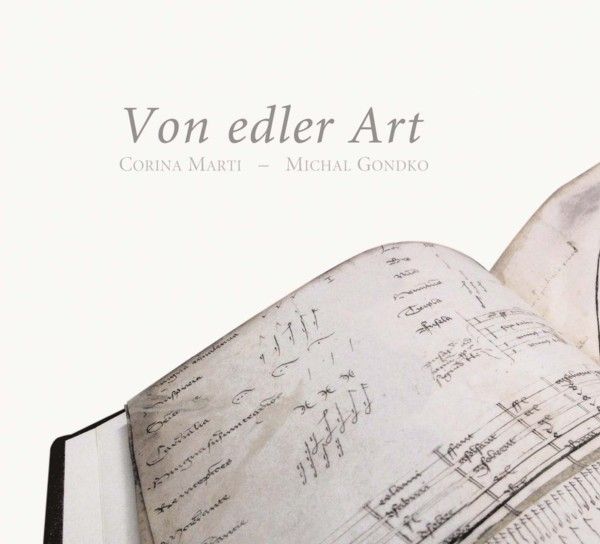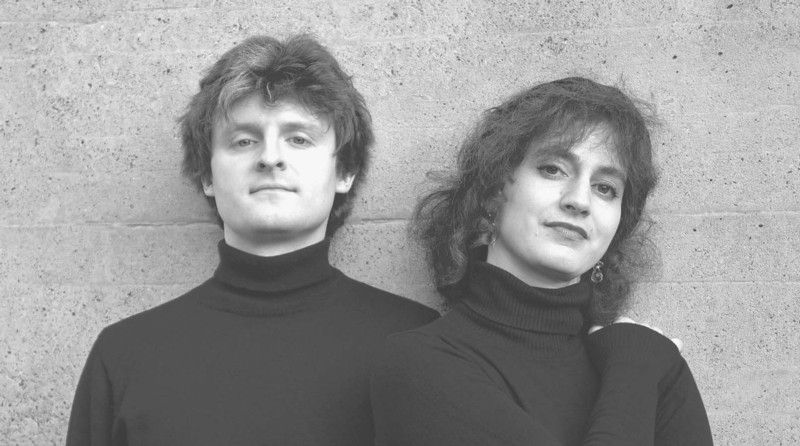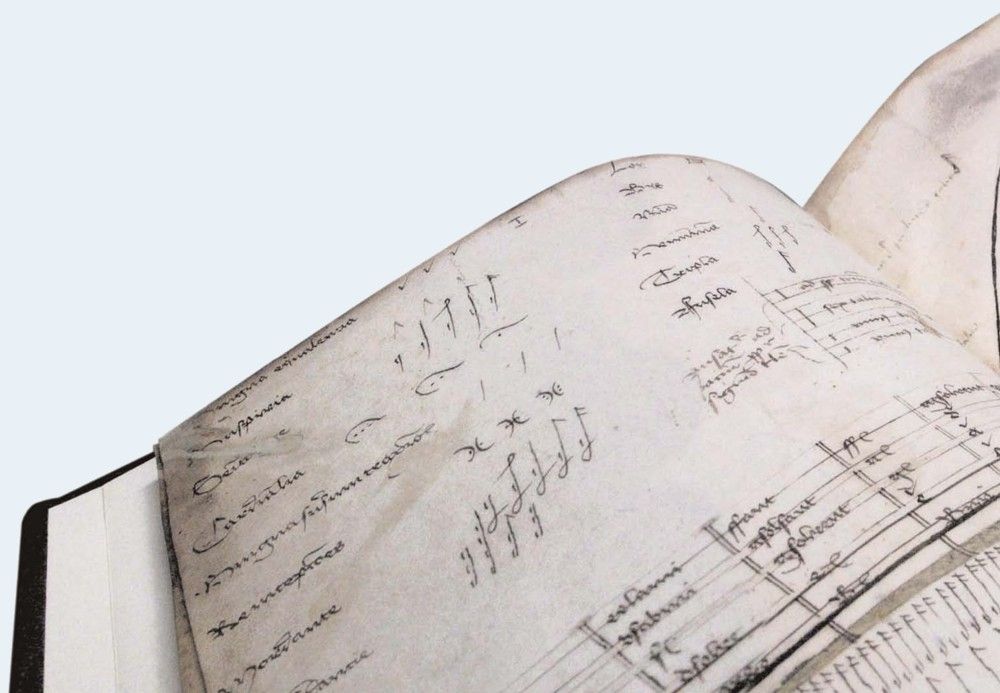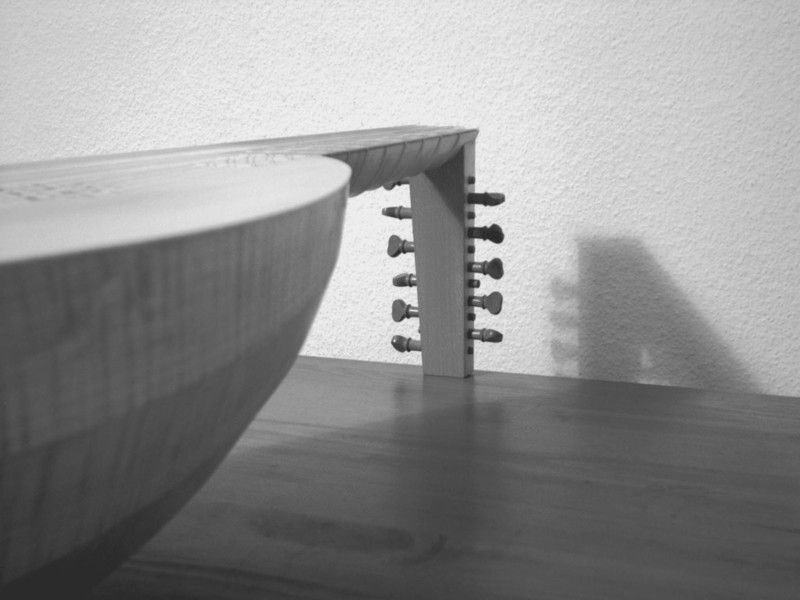
medieval.org
diverdi.com
ramee.org
lamorra.info
Ramée 0802
2008

medieval.org
diverdi.com
ramee.org
lamorra.info
Ramée 0802
2008
1. GUILLAUME DU FAY. [Ce jour le doibt] · arr. M. Gondko
· gittern, claviciterium [4:35]
2. Wilhelmus legrant, after Guillaume LEGRANT [Lemacherier] · gittern,
claviciterium [1:40]
3. Des klaffers neyden · gittern [1:39]
4. Benedicite almechtiger got · claviciterium
[3:03]
5. ?TYLING. [Tandernaken] · gittern, claviciterium
[3:19]
6. Praeambulum super sol [0:44]
7. Qui vult messite, after Gilles de BINS dit BINCHOIS. Qui veut
mesdire [3:32]
8. Praeambulum super c [2:12]
9. Pulcherrima de virgine · arr. M. Gondko [2:31]
10. ?BOUMGARTNER. Boumgartner [2:02]
lute
11. Preambulum super d [2:15]
12. Rorate celi desuper et nubes pluant [3:30]
13. Redeuntes in la [1:02]
14. Modocomo bystu die rechte / Repetic[i]o, upon an. Ma doulce amour
[6:13]
15. Redeuntes in idem [1:10]
16. Mi ut re ut e c d c, upon an. Venise [3:09]
17. Redeuntes in idem mi de eadem mensura [1:51]
claviciterium
18. JOHANN SCHLEND. Ich stond an einem morgen · claviciterium,
lute [1:15]
19. ARNOLT SCHLICK.All ding mit radt · lute
[2:41]
20. HANS BUCHNER. Enzindt pin ich · claviciterium, lute
[1:41]
21. HANS KOTTER. Praeludium in la · claviciterium
[2:40]
22. PAUL HOFHAIMER. Tandernack uf dem rin lag · claviciterium,
lute [3:25]
23. ?ADOLF BLINDHAMER. Preambulum (abridged) [6:49]
24. SYLVANUS OR WENCK. Mein Gmüt und Blüt [1:21]
25. ADOLF BLINDHAMER. Meyn sin und gemüt [1:34]
26. ADOLF BLINDHAMER. AB mit 3 stimen [1:28]
lute
CORINA MARTI, claviciterium
Emile Jobin, after anonymous, ?Ulm, late 15th century, now in the
Donaldson Collection, Royal College of Music, London
MICHAL GONDKO
6-course lute in A
Szymon Gasienica / Marcus Wesche, after iconographical sources
4-course gittern in C
George Stevens, after Hans Ott, Nuremberg, ca. 1450, now in the
Wartburg Castle, Eisenach
All instruments strung with gut strings by Aquila and Sofracob.

BIOGRAPHICAL DATA
Guillaume Du Fay / * Beersel, ?5 Aug 1397; † Cambrai, 27 Nov 1474
Gilles de Bins dit Binchois / * ?Mons, c 1400; † Soignies, 20
Sept 1460
Guillaume Legrant [Lemacherier]/ flourished 1405-49
Tyling (?composer's name) /unknown
Boumgartner (? composer's name) /unknown
Conrad Paumann / * Nuremberg, c1410; † Munich, 24 Jan 1473
Paul Hofhaimer / * Radstadt, 25 Jan 1459; † Salzburg, 1537
Arnolt Schlick / * ?Heidelberg, c1460; † ?Heidelberg, after 1521
Adolf Blindhamer / * c1475; † between 1520 and 1532
Hans Buchner / * Ravensburg, 26 Oct 1483; † ?Konstanz, 1538
Hans Kotter / * Strasbourg, c1485; † Berne, 1541
Johann Schlend / ?Alsace; dates of birth and death unkown
Andreas Sylvanus (Walder) / flourished in Heidelberg, 1511
Johann Wenck/unknown
MANUSCRIPT SOURCES
Vienna, Österreichische Nationalbibliothek, Ms Mus. 5094 [track 1]
Berlin, Staatsbibliothek, Preussischer Kulturbesitz, Mus. 40613
(» Lochamer Liederbuch«) [tracks 2-4]
Trento, Castello del Buonconsiglio, Monumenti e Collezioni Provinciali
1374 [olim 87] [track 5]
Munich, Bayerische Staatsbibliothek, Mus. 3725 (» Buxheimer
Orgelbuch«) [tracks 6-17]
Basel, Universitätsbibliothek, F X 1-4 [tracks 18 and 20]
Basel, Universitätsbibliothek, F IX 22 [tracks 21-22]
Vienna, Österreichische Nationalbibliothek, Ms Mus. 41950 [tracks
23, 25 and 26]
PRINTED SOURCES
Arnolt Schlick, Tabulaturen Etlicher lobgesang und lidlein uff die
orgeln und lauten (Mainz: Peter Schöffer, 1512) [track 19]
Georg Forster, Ein außzug guter alter un[d] newer Teutscher
liedlein (Nuremberg: Johan Petreius, 1539) [track 24]
BIBLIOGRAPHY
Anthony Baines, »Fifteenth-Century Instruments in Tinctoris's De
Inventione et Usu Musicae«, The Galpin Society Journal, Vol.
3. (1950), pp. 19-26
Standley Howell, »Paulus Paulirinus of Prague on Musical
Instruments«, Journal of the American Musical Instrument
Society, vol. 5/6 (1979/80), pp. 9-36
Martin Kirnbauer & Crawford Young, Frühe Lautentabulaturen
im Faksimile / Early Lute Tablatures in Fascimile (Winterthur:
Amadeus Verlag, 2003, Pratica Musicale 6)
Keith Polk, German Instrumental Music of the Late Middle Ages:
Players, Patrons and Performance Practice (Cambridge: Cambridge
University Press, 1992)
Keith Polk, »Innovation in Instrumental Music 1450 - 1510: The
Role of German Performers within European Culture«, in: John
Kmetz (ed.), Music in the German Renaissance: Sources, Styles, and
Contexts (Cambridge: Cambridge University Press, 1994), pp. 202-14
Reinhard Strohm, The Rise of European Music 1380-1500
(Cambridge: Cambridge University Press, 1993)
Stanley Sadie & John Tyrell (eds.): The New Grove Dictionary of
Music and Musicians, 2nd edition (London: Macmillan Publishers,
2001)
Sebastian Virdung, Musica getutscht 1511, facsimile edition,
ed. Klaus Wolfgang Niemöller, Documenta Musicologica, Erste Reihe:
Druckschriften-Faksimiles, XXXI (Kassel-Basel-London: Bärenreiter,
1970)
Recorded in July 2007 at the church of Notre-Dame de l'Assomption,
Basse-Bodeux, Belgium
Recording, artistic direction & production: Rainer Arndt
Editing: Catherine Meeùs, Rainer Arndt
Graphic concept: Laurence Drevard
Design & layout: Laurence Drevard (cover), Catherine Meeùs
(booklet)
Cover: Kasseler Lautenkragen, Germany, late 15th century
(© Universitätsbibliothek Kassel, part of the manuscript 2°Ms.
math. et art. 31)
Photos: © Laurence Drevard (cover), © Michal Gondko (booklet)
With special thanks to Ann and Paul Bridge, Michael Craddock and Martin
Kirnbauer.
RAM 0802
www.ramee.org
Martin Kirnbauer. À LA RECHERCHE DU SON PERDU
(English translation)

VON EDLER ART
One of the defining features of the secular musical culture of
fifteenth-century Europe is the division of musical instruments (and
thus music performed with them) into «loud» and
«soft»; «loud» music (provided by a wind band
consisting of reeds and brass) was associated with large in and outdoor
courtly and civic events of all sorts, and «soft» (any
instrument that produced considerably less volume) with a more intimate
setting. Both kinds of music were performed by professional musicians.
While an excellent instrumentalist could obviously come from anywhere,
music historians point out that courts, cities, churches and private
chambers in many parts of late medieval and early modern Europe very
often echoed to fine music provided by German players of wind and
stringed instruments. It has even been said that German
instrumentalists «excercised analogous primacy in their sphere of
activity» to «the primacy of Franco-Flemish composers in
vocal music and composition» (Keith Polk). Sadly, considering the
vigour of this instrumental tradition in German-speaking lands, the art
of these instrumentalists has left relatively little trace in written
musical accounts. It is widely presumed that most players would have
learned their craft and passed it on by ear (the music either
improvised or conceived and stored in their memory rather than written
down), so that the music lasted only as long as those who created and
performed it. However, the question remains, did it disappear entirely?
Most of the surviving fifteenth-century instrumental music that can be
directly linked to the activity of German instrumentalists comes from
the realm of keyboard playing. This fact has implications beyond the
history of keyboard playing alone. In German keyboard manuscripts
pre-dating the early sixteenth century, the top part of a polyphonic
composition is notated mensurally on a staff, whereas the remaining
parts are notated underneath with letters of the alphabet (to denote
pitch) and rhythmical signs – a system termed nowadays
«older German organ tablature». Intended for keyboard
instruments in the first place, this way of notating polyphonic music
is nevertheless a versatile one, for the resulting intabulation does
not exclude a performance in solo or duet arrangements by any suitable
«melodic» or «polyphonic» instrument.
Furthermore, lutenists (and possibly harpists) could read keyboard
notation (see Martin Kirnbauer's essay in the present booklet).
The notion of polyphonic solo lute playing – the instrument's
chief role in the sixteenth century – was developed during the
fifteenth century, undoubtedly with a significant contribution from
German players. Conrad Paumann, a virtuoso organist and player of
«soft» instruments, in his day one of the most remarkable
musical personalities in German-speaking lands, was renowned for his
polyphonic solo lute playing, apparently using the bare fingers of the
right hand. Johannes Tinctoris, music theorist and keen observer of the
contemporary musical world, considered this style of lute playing
superior in difficulty to traditional melodic playing (using a
plectrum) and Paumann «supereminent in playing this way».
There were others who practiced this multo difficilius style of
playing: Tinctoris also singles out Charles the Bold's lutenist Henri
Bouclers, whose origin has not yet been traced (though it has been
suggested that his name may be a garbled version of «Heinrich
Böcklin») and one suspects polyphonic performance whenever a
single lutenist appears in fifteenth-century courtly or civic payment
records, particularly in German-speaking areas.
A look through the Buxheimer Orgelbuch – the most
extensive of the surviving fifteenth-century manuscripts in German
keyboard notation – reveals types of repertoire likely to have
been performed by Paumann and his students around the middle of the
century. It contains both sacred and secular works, including pieces
with a primarily liturgical function (extemporisations of chant
melodies), arrangements of secular songs, basse danse tenors
and free instrumental forms. The existence of so-called fundamenta
– collections of pre-conceived solutions for extemporisation on
the fundamental melody – opens yet another door. Not
surprisingly, the most extensive of such collections – Fundamentum
organisandi, surviving in the Buxheimer Orgelbuch and
elsewhere – is attributed to Conrad Paumann. For his students, a Fundamentum
organisandi would have been a valuable learning aid, a window into
their master's workshop, and its content subject to emulation and
copying. Taken together, didactic material and the music itself (with
multiple types of arrangement existing for many pieces) constitute the
vocabulary and grammar of the musical language used by fine musicians
like Paumann. Once learnt, this language can be used by present-day
players for extending the repertoire by creating new arrangements of
any polyphonic piece likely to have been chosen by a fifteenth-century
musician (i.e. a song by Binchois). Thus, surviving fifteenth-century
German manuscripts of keyboard music preserve for us not only valuable
musical material from the early days of German keyboard playing
tradition. They also transmit what might be the lost repertoire of
fifteenth-century German players of «soft» instruments,
albeit only a fraction of it. Study of their content helps to partly
mitigate the loss – an invaluable resource for present-day
musicians with instruments for which the earliest repertoire otherwise
dates from the sixteenth century.
The late Middle Ages saw crucial developments in instrument-making and
many of them took place in German-speaking lands. In order to meet the
requirements of changing tastes in music and aesthetics, new
instruments were invented, and existing ones modified and improved.
Some of the most dramatic developments occurred in the field of
stringed instruments. Experiments with various mechanics led to the
invention of new stringed keyboard instruments that flourished in
various forms and types (including the harpsichord, allegedly an
invention of the Austrian physician Hermann Poll shortly before 1400) .
Among them was the claviciterium, an upright stringed keyboard
instrument with a vertical soundboard. Sebastian Virdung gives only a
vague description of the claviciterium in his 1511 treatise Musica
getutscht: «This one is similar to the virginal, only that it
has strings made of sheep's gut, and [bray?] pins that make it sound
like a harp; it also has feather quills like the virginal. It was
invented recently and I have only seen one». While the
claviciterium was not really a novelty (the earliest evidence of its
existence dates from around 1460), it seems to have been a rarity. This
is possibly why a beautiful late fifteenth-century specimen of South
German origin survived. To date, it remains the earliest stringed
keyboard instrument in existence. Around 1460, the theorist Paulus
Paulirinus wrote that the claviciterium was strung with metal strings
whereas Virdung mentions gut. The instrument heard in the present
recording is strung with gut strings, as we have a preference for the
kind of sound they produce, and – last but not least –
because it blends wonderfully with the sound of the entirely gut-strung
lute and gittern.
The lute gradually lost its «gothic» appearance
(characterised by flowing contours and a roundish body) in favour of
new designs developed by South German makers in the late fifteenth
century. Thanks to the testimony of Tinctoris, we know that Germans
experimented with the stringing of the lute, adding the sixth course,
trying out materials other than gut and enhancing the sonority of the
bass register – adaptations likely to have been triggered by
developments in playing technique and the music itself. Writing around
1500, Virdung mentions three types of lute as being in use in his time:
5-course (9 strings), 6-course (11 strings) and 7-course (13 or 14
strings). A 5-course instrument was in use in Europe at least from the
early fifteenth century onwards and, in all likelihood, this was the
type of lute that Paumann began on and played for most of his career.
Virdung considers 5- course lutes inadequate («I consider nine
strings too few to learn [the lute]») and 7-course lutes too rare
(«not all lutes have thirteen or fourteen [strings]»), so
he advises his reader to use a 6-course instrument (since «one
finds them practically everywhere»). A small 6-course lute, tuned
A – d – g – b – e' – a' was also adopted
for this recording. A variant of this tuning with the bottom course
tuned a whole tone down was often used by lutenists in Germany (here
called Abzug) as well as elsewhere in Europe. Virdung also
mentiones a gittern (Quintern) . A smaller relative of the lute,
with body and neck made from a single piece of wood, the gittern came
to Europe from Arab lands at some point in the thirteenth century,
possibly around the same time as the lute. The instrument heard on this
recording is based on a surviving specimen made by Hans Ott in
Nuremberg around 1450. Its four courses are tuned a – d' –
g' – c".
Divided into sets of pieces, our chronologically ordered program
strives both to capture a glimpse of this essential moment of
development in the history of keyboard and plucked string playing, and
equally to present a practical implementation of ideas gained from the
analysis of sources. The initial set consists of both duets and solo
pieces, beginning with an intabulation of Guillaume Du Fay's May song Ce
jour le doibt from an earlier fifteenth-century Austrian
manuscript. Significantly, instead of tablature, the scribe used
mensural signs to notate this piece in the usual keyboard score layout.
The florid Wilhelmus legrant – an intabulation of an
otherwise unknown piece by the early fifteenth-century French composer
Guillaume Legrant (Lemacherier) – demonstrates the musical
plausibility of a duet performance of music written in keyboard
notation. Conversely, we have intabulated a mensurally written setting
of the Tandernaken melody from a manuscript written by Johannes
Lupi (see Martin Kirnbauer's essay). Inserted between the duets and
performed by each instrument solo are two musically related
intabulations of German Lieder, notated – like Wilhelmus
legrant – in the keyboard part of the Lochamer Liederbuch,
another manuscript containing Paumann's Fundamentum (here dated
1452).
The next two sets consist exclusively of music from the Buxheimer
Orgelbuch performed solo on lute and claviciterium respectively.
Here, the listener will find songs (Binchois' Qui veut mesdire
and a composition signed Boumgartner), settings of basse danse
tenors (Venise and Ma doulce amour) and pieces with
Latin titles (Pulcherrima de virgine and Rorate celi desuper
et nubes pluant). A simple, two-part composition notated towards
the end of the manuscript, Pulcherrima de virgine, served as a
point of departure for a more elaborate reworking that involves
ornamenting the top part and a partial thickening of the polyphonic
texture to three-part. As frames and dividers, we have used pieces in
free forms dispersed throughout the Buxheimer Orgelbuch: preambula
and redeuntes serve as preludes, interludes and postludes (the
latter in the spirit of Nachlauf – the virtuoso ending of
a piece). In fact, the little Nachlauf immediately following Boumgartner
and concluding the solo lute set has been spontaneously improvised and
retained in the recording.
With the fourth set, again a mixture of duets and solo pieces, we move
in time towards the early sixteenth century. It is from this period
that we possess further keyboard sources as well as the earliest
surviving German sources of lute music already written in a
lute-specific notation, the «German lute tablature»
(invented – if we are to believe the testimony of Sebastian
Virdung – by Paumann, it uses numbers for open strings and
letters of the alphabet for places on the fingerboard instead of
pitches). This set is dominated by music of keyboard players of the
post-Paumann generation, with Paul Hofhaimer, obrister Organist
(chief organist) to Emperor Maximilian I, as its foremost exponent. The
set opens with Ich stond an einem morgen by Johann Schlend, of
whom nothing is known except that he was organist in the town of Zabern
(now Saverne in Alsace). The piece survives in part-books compiled in
the second decade of the sixteenth century for Bonifacius Amerbach, a
Basel lawyer and amateur musician on keyboard, plucked stringed and
wind instruments. It is followed by a prelude-like lute piece All
ding mit radt from Arnolt Schlick's printed anthology Tabulaturen
Etlicher lobgesang, and by two compositions by Hofhaimer's
students, Hans Buchner and Hans Kotter. Like Schlend's piece, Buchner's
Enzindt pin ich is a standard, mensurally notated four-part
setting of a pre-existing melody. We have arranged both pieces as
duets, assigning the superius and tenor parts to the
claviciterium, while altus and bassus parts are given
to the lute (in the 1530s, similar arrangement was recommended for the
lute duet by lutenist and music publisher Hans Gerle) . The two
concluding pieces come from a keyboard manuscript written by Kotter
around 1515 for the young Bonifacius Amerbach: Kotter's Praeludium
in la serves as an introduction to Hofhaimer's elaborate setting of
the Tandernaken melody (our choice for the additional part is a
lute played with a plectrum).
This recording would seem seriously incomplete without at least some of
the solo lute music ascribed to Adolf Blindhamer. He was lutenist to
Emperor Maximilian I and lute teacher in Nuremberg; Albrecht Dürer
considered him as one of the three best lutenists of his time –
alongside Felix Hungersperger and a certain «Samario» (who
may well have been Gian Maria Alemani (Giudeo), a German-Jewish
lutenist to Pope Leo X) . We are indebted to Hans Gerle, possibly
Blindhamer's student in Nuremberg, for an illuminating account of
Blindhamer's solo performance: «In order to expand his art and
ability, the aforementioned Adolf proceeded in this fashion which all
artists of music and of these instruments should adopt. When he played
in front of those versed in music or famous singers he nevertheless let
himself be heard beforehand in his preludes in such a way that his
precision and art appeared great. Also, when he performed a set piece,
he played it at first as it stood in the score, ornamented only with
few coloraturas, secondly with well formed runs, and thirdly he played
and executed it with proportions, but in such a way as not to take away
from the sweetness and perfection of the piece».
Accordingly the last set consists of several pieces signed
«AB» and «Adollf Blindhomer» in a South-German
manuscript from the second decade of the sixteenth century. Inspired by
Gerle's evocative testimony, the set opens with a Preambulum,
not attributed, but sharing much of the musical materia with
Blindhamer's untitled piece found later in the manuscript. The hastily
scribbled and extremely long Preambulum is largely based on
extended repetitive modules calling to mind Paumann's clausulae
(examples of extemporising a movement of melody) but organised
rhythmically in a variety of ways and peppered with short comments
(i.e. behend, «nimble», or lenge,
«stretch»). Most interestingly, only after the beginning,
the piece requires the lutenist to tune the bottom course of the lute a
whole tone down – this kind of «in-composed» Abzug
is quite unique in the sources of lute music and has been retained in
the recording. The overall feeling of improvisatory freedom that this
piece evokes is strong. This sort of piece (when already notated) is,
by definition, no opus perfectum et absolutum. Therefore, for
the purpose of this recording, the middle section of the Preambulum has
been removed in the interest of greater formal cohesion, yet the piece
loses nothing of its rhapsodic character. After the final run (Nachlauf),
the Preambulum leads on to the song Mein Gmüt und
Blüt by either Andreas Sylvanus or Johann Wenck. The song is
first performed as it stands (only lightly adorned in cadences), and
then repeated in the florid arrangement by Blindhamer which the scribe
entitled Meyn sin und gemüt. The set is concluded by
Blindhamer's aforementioned untitled piece which is essentially a
compressed version of the initial long Preambulum. Blindhamer's
music is technically and musically demanding. As we know it today
– transmitted by an anonymous scribe, possibly an advanced
student – it constitutes yet another valuable insight into what
must have been a world of highly personal instrumental performance
practices. Like his contemporary fellow organists, Blindhamer lived
well into the sixteenth century, but had received his education –
undoubtedly based on older models – in the preceding one.
Interrelated traditions of keyboard and lute playing that flourished in
German-speaking lands in the age immediately predating the invention of
music printing have fascinated us ever since our very first encounter
with the surviving repertoire that originated from these traditions.
Fifteenth-century music for keyboard and plucked stringed instruments
is without doubt an exciting area in the early history of European
instrumental music, but one paradoxically seldom visited by performers
and thus virtually unknown to the wider public. Many pieces are
recorded here for the first time, and it is our hope that the present
disc may contribute to restoring the remnants of a once flourishing and
highly refined art to the place they deserve in the awareness of music
lovers.
Michal Gondko
